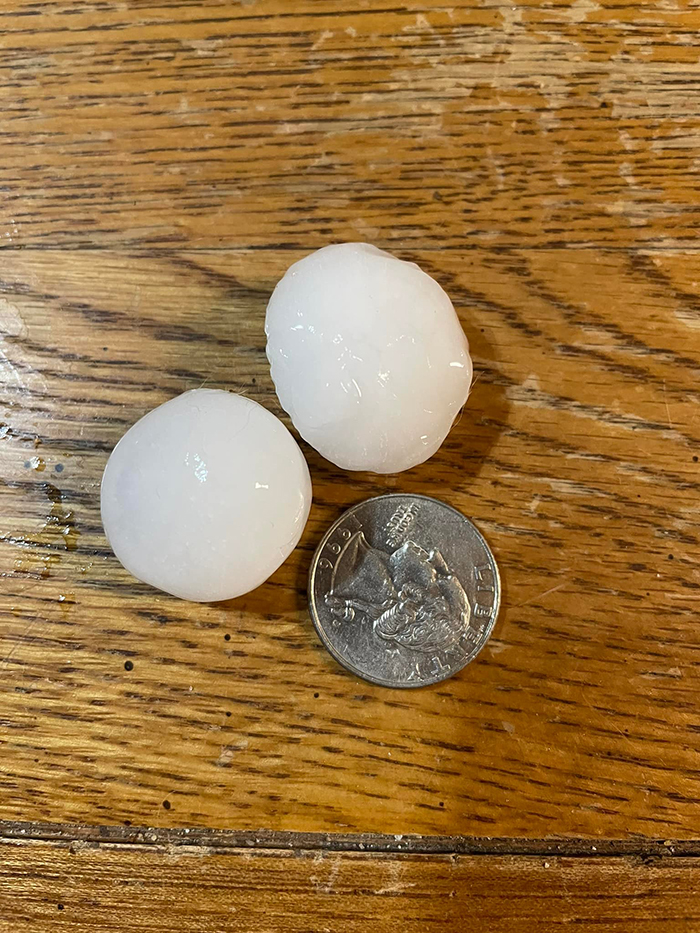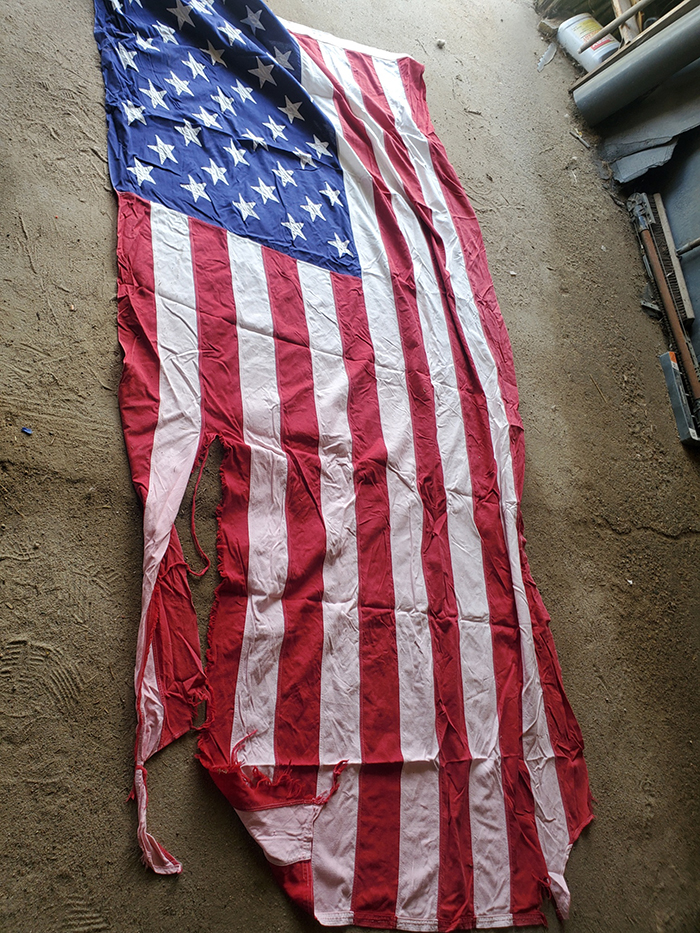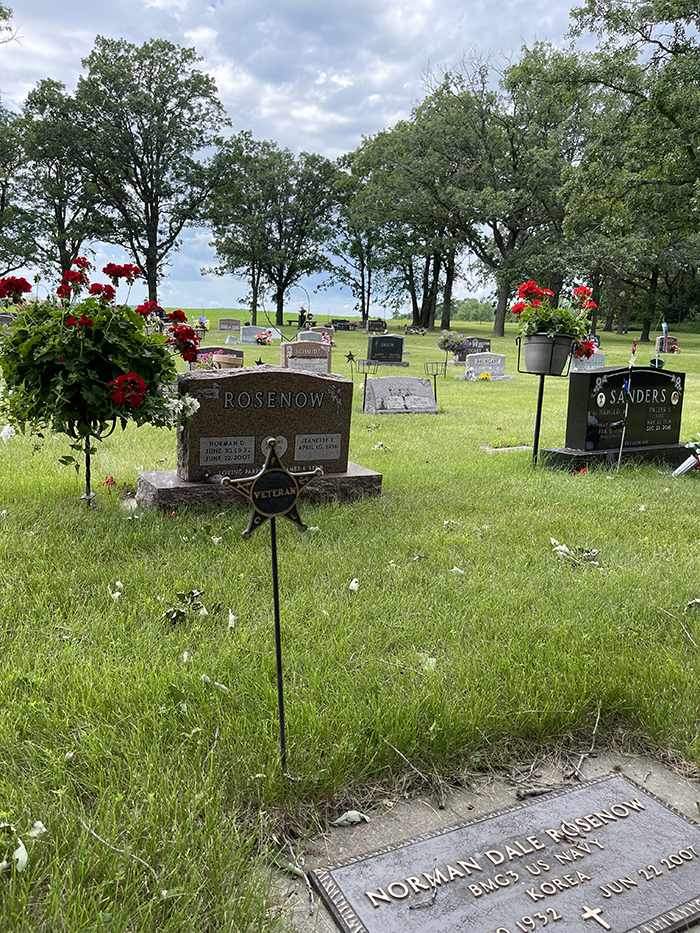Avenue of Flags suffer weather damage
News | Published on July 21, 2022 at 1:39pm EDT | Author: Chad Koenen
0Hail damage continues summer storm streak

Hail was reported throughout the area on Sunday with reported sizes ranging from quarter to baseball-size continuing a streak of damaging storms that have hit the region over the past three weeks.
By Kathryn Wilkowski and Robert Williams
During the Memorial Day storms in May, a total of 36 flags from the Avenue of Flags were damaged beyond use. Shredded and unfixable, Rochelle Nordquist and Roger Schaefer are looking for donations to help cover the costs of the horrific damage.
“This year has had the worst storms in a long time. Between the wind damage, tree damage, and then the bent poles, we have a bunch of flags to fix,” they said.
The Avenue of Flags was first started in 1991. In 1995, the community club became a part of the program.
Kept behind the big turkey for living veterans and the Lakeside Cemetery for deceased veterans, there are more than 160 flags being used to represent the veterans in the community.
“We only put the flags up in the cemetery for Memorial Day due to not enough help for the Fourth of July or Turkey Days,” Nordquist said. “So we only get to do the flags behind the turkey for the living veterans on those events.”
Not only looking for money donations or 5×8 flag donations, both Nordquist and Schaefer are looking for volunteers who want to pay respect to veterans and offer help to the community.
“Our older veterans who were very dedicated to showing off the flag can’t help out anymore,” Schaefer said. “Back in 1991, when this whole thing first started, a lot of them are gone and can’t help.”
To reach Rochelle on information about donations and volunteering, call her at (218) 396-0368.
“We need to remember the veterans,” they said. “We do it to honor everybody who served and give back to the community.”
Hail damage reported around the area

Southern Becker County has been a target of damaging weather the past month with two rounds of storms on Sunday, July 10, affecting the region with sizable hail, heavy rains and wind.
The first storm struck in the morning hours and the second during the afternoon and evening. Damaging winds were the predominant threat during the morning, with large hail being the main threat during the afternoon/evening convection, according to the National Weather Service (NWS) in Grand Forks.
The highest reported wind speed by the NWS was 68 miles-per-hour prior to the storms moving east and fizzling out near Duluth.
Hail up to 1.25 inches was reported in Frazee at 1:40 p.m., and multiple residents posted photos of quarter-sized to ping pong ball-sized hail from the Height of Land Lake area to the Frazee city limits. Golf ball-sized hail was also reported on a stretch of highway 34 before the storms moved off towards the southeast into central Minnesota.
Some social media users southeast of Osage reported finding hail the size of baseballs.
June and July are the wettest months on average in the region with June topping the NWS chart with an average of nearly 5-inches and July near 4.35-inches.
The storms followed up the EF-2 tornado that left a 30-mile stretch of destruction from the Pickerel and Cotton Lake area all the way to Wolf Lake and Menahga in late June.
DNR assistance available for storm damage
The Minnesota Department of Natural Resources has resources and foresters available to help landowners manage woodlands damaged by recent tornadoes and storms.
“Seeing trees down in your woods and coming up with a plan for cleanup can be overwhelming,” said Jennifer Teegarden, cooperative forest management outreach specialist. “Be sure to take advantage of the help the DNR can provide to you.”
The DNR has cost-share funds to help affected woodland owners remove downed and damaged trees and to reforest their woods.

A DNR forester can assess the damage and help develop a project plan to manage woodlands. The forester may also be able to assist a woodland owner enroll in the DNR’s cost-share program designed to help woodland owners improve their woods. Additionally, foresters can discuss the benefits of getting a Woodland Stewardship Plan as a way to meet woodland goals, improve the health of the woods, and enroll in tax incentive programs.
Storms are one way nature helps rejuvenate the landscape. Often, strong winds blow down unhealthy or decayed trees in a forest, creating openings for younger, healthier trees that can benefit wildlife. Leaving some downed trees in the woods can create wildlife habitat.
A timber harvest to remove downed and damaged trees can make woods safer and more accessible for future recreation and management activities. A timber harvest also is a way to keep woods healthy, meet woodland ownership goals, and make woods more resilient to future storms.
A professional forester can appraise timber, help find the right logger, and monitor harvest. A DNR forester can either help with a timber sale or connect woodland owners with a professional forester who can provide assistance.
Visit the DNR’s Forest Stewardship page of the DNR website (www.mndnr.gov/ForestStewardship) to learn how the DNR works with private woodland owners, get information about cost-share, and to find an area forester.

